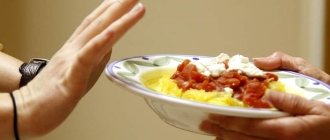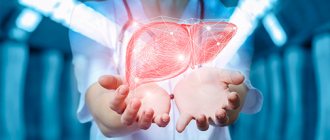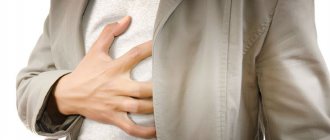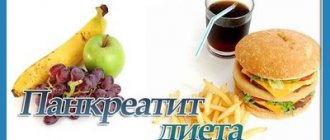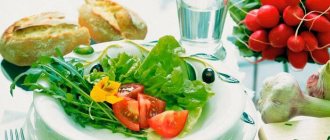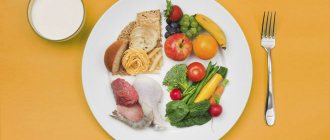General rules
Erosive lesions of the gastroduodenal zone are widespread and are diagnosed in 10-15% of cases in patients during endoscopic examination of the gastrointestinal tract.
Erosions (single/multiple) are a superficial defect of the tissues (mucosa) of the stomach without involving the deeper layers of the organ in the process, formed both against the background of severe swelling/hyperemia of the mucous membrane, and against the background of minimal inflammatory manifestations and even in their absence. Erosion heals without scar formation. The development and progression of the erosive process in the gastroduodenal zone is based on the predominance of aggressive factors affecting the mucous membrane (HCl/pepsin) over its protective properties (cellular regeneration, mucous-bicarbonate barrier) and insufficient blood supply to the gastric mucosa.
Erosive gastropathy occurs under the influence of various reasons, the main of which are: stress syndrome, aggressive effects of a number of drugs (salicylates, NSAIDs, prednisolone ), alcohol abuse, against the background of injuries, burns, sepsis, chronic gastrointestinal diseases ( gastritis , chronic cholecystitis , duodenal ulcer ), diabetes mellitus , severe conditions accompanied by cardiac, renal , liver failure.
The formation of gastric/duodenal erosions is also facilitated by reverse gastroduodenal reflux and contamination of the gastric mucosa by the bacterium Helicobacter pylori. In the clinical symptoms of various variants of acute/chronic erosive gastropathy there are no specific symptoms, except in cases of severe hemorrhagic form, which is characterized by ulcerative symptoms and it is possible to differentiate gastric erosions from ulcers only with gastroscopy .
Diet for erosion of the stomach and duodenum is a standard method of conservative therapy. Therapy of erosions of the gastroduodenal zone implies the need to examine patients for H. pylori infection. If the result is positive, treatment of the disease begins with the appointment of eradication therapy with antibacterial drugs to which Helicobacter pylori has no resistance and probiotic drugs in order to correct the intestinal biocenosis.
The basis of therapeutic nutrition for erosion of the stomach and esophagus with normal/high acidity of gastric juice is dietary Table No. 1 and its varieties - 1A and 1B (for acute form/exacerbation of chronic erosive gastropathy ). This treatment table creates all the conditions for the healing of the erosive defect, since the diet does not contain foods that stimulate gastric secretion and rough foods that irritate the mucous membrane. The protein content in the diet at the level of the physiological norm has a beneficial effect on reparative processes, and the fractional nature of nutrition and a reduction in the volume of portions determines mechanical sparing of the mucous membrane.
The diet of Diet No. 1 limits all foods/dishes that enhance the secretory functions of the gastric glands (concentrated broths from any products) and irritate the mucous membrane (smoked, salted and pickled foods, carbonated drinks, spices and seasonings, fried foods, raw vegetables). Long/difficult to digest foods, salt, and very cold/hot dishes are excluded. In the acute form/exacerbation of chronic erosive gastropathy, food is prepared using the most gentle methods possible (boiled/steamed) and served pureed.
When the condition improves, pureed food is replaced with unprocessed food. With increased acidity in the diet, the consumption of easily digestible carbohydrates (sugar, jam, sweets, honey and other sweets) will be limited, which will reduce the secretory activity of the stomach and its excitability.
The diet for gastric erosion provides for consistency and continuity in the appointment of treatment tables: 1A (7 days), 1B (up to 10-14 days) and Table No. 1 (up to 2-3 months), which allows you to achieve the required level of sparing of the mucous membrane and long-term remission. Puréed food is prescribed only in the first few days, and then the patient is transferred to a non-purified diet with the inclusion of non-rough foods and mandatory thorough chewing of food. Transferring the patient to a common table involves regular meals with a limit on too spicy, spicy, hot/cold foods and alcohol-containing drinks.
Diet for gastric erosion menu for a week. Diet rules for gastric erosion
A diet for gastric erosion is a balanced diet that allows you to restore the affected mucous membrane in a short time if you follow the rules. Before talking about what you should and can eat, you should look at the foods that are recommended to be excluded.
Nutrition for this type of pathology excludes all products that can mechanically injure the stomach. You should not eat too hard foods, for example, dry foods (sandwiches, crackers, cookies), hard varieties of vegetables and fruits. Food must be chewed thoroughly so that it enters the stomach in a partially processed form. This is especially necessary for erosive and ulcerative processes. In this case, it is not possible to digest complex foods on your own. This provokes stagnation of food in one of the sections of the gastrointestinal tract, poor absorption of nutrients and fermentation processes.
All components of the diet should be soft, and it is better to eat food pureed. Strong coffee and alcohol should be avoided. The first drink stimulates the production of acids, which increases the destruction of the already damaged mucous membrane. Alcohol acts even more aggressively and can provoke the transition of erosion into an ulcer in the shortest possible time. Wine, beer, cocktails and other drinks with low alcohol content are especially dangerous.
You should exclude vegetables and fruits, which take a long time to digest and stimulate increased secretion. These include:
- radish;
- onion;
- garlic;
- eggplant;
- tomatoes;
- pumpkin;
- cabbage;
- apples;
- citrus;
- grape;
- plum
It is necessary to exclude all sour varieties of fruits and berries during treatment. It is not recommended to consume chocolate, cakes, pastries and all types of pastries. Contraindicated are semi-finished products, strong meat broths, fatty and fried foods, smoked sausages, sausage and chicken. Kebabs and other grilled dishes (especially meat) are also not recommended.
All carbonated drinks, including mineral water, are excluded. It is not recommended to chew gum, especially on an empty stomach. This process stimulates the production of acids for digestion. As a result, food does not arrive, and gastric juice begins to damage the walls of the organ.
Authorized Products
Diet for erosion of the stomach and duodenum includes:
- Vegetable soups with the addition of oatmeal, buckwheat, rice cereals, which are thoroughly pureed, and when the condition improves - with well-cooked and mashed cereals and finely chopped vegetables. To improve the taste, butter, low-fat cream, egg-milk mixture, meat puree, and non-garden herbs (dill or parsley) are added to first courses.
- Low-fat varieties of red meat and poultry (beef, young lamb, lean pork, turkey, chicken), rabbit in the form of steam cutlets, meatballs, zraz, quenelles, soufflé. When the process subsides, lump meat, boiled/baked in the oven, is introduced into the diet.
- River/sea fish in the form of quenelles, cutlets, meatballs of cod, pollock, pike, hake, ice fish.
- Dried bread made from premium wheat flour, crackers, savory buns.
- Cereals: oatmeal, buckwheat, mashed/well-cooked white rice with milk and butter.
- Mild homemade sauces made with milk/low-fat cream.
- Fresh non-sour cottage cheese, lazy dumplings, cottage cheese soufflé, baked cheesecakes, milk jelly. Cream and sour cream are added to ready-made soups and mashed potatoes. Milk is allowed to be consumed in quantities of no more than 800 ml.
- Soft-boiled eggs/steam omelet (2-3 pieces), added to soups and other dishes. Butter up to 20 g/day and refined vegetable oil as additives to ready-made first and second courses.
- Cooked berries (jelly, jelly, mousse). Apples baked in the oven with honey/sugar. Cannot be consumed fresh. For dessert - honey, caramel, meringues, marshmallows, meringue, jam, marshmallow.
- Free liquid of at least 1.5 l/day in the form of a decoction of wheat bran, freshly prepared diluted juices from berries/fruits, weak tea with milk, rosehip infusion, carrot juice, non-carbonated mineral water.
Table of permitted products
| Proteins, g | Fats, g | Carbohydrates, g | Calories, kcal | |
Vegetables and greens | ||||
| zucchini | 0,6 | 0,3 | 4,6 | 24 |
| cauliflower | 2,5 | 0,3 | 5,4 | 30 |
| potato | 2,0 | 0,4 | 18,1 | 80 |
| carrot | 1,3 | 0,1 | 6,9 | 32 |
| beet | 1,5 | 0,1 | 8,8 | 40 |
| pumpkin | 1,3 | 0,3 | 7,7 | 28 |
Fruits | ||||
| apricots | 0,9 | 0,1 | 10,8 | 41 |
| watermelon | 0,6 | 0,1 | 5,8 | 25 |
| bananas | 1,5 | 0,2 | 21,8 | 95 |
| melon | 0,6 | 0,3 | 7,4 | 33 |
| nectarine | 0,9 | 0,2 | 11,8 | 48 |
| peaches | 0,9 | 0,1 | 11,3 | 46 |
| apples | 0,4 | 0,4 | 9,8 | 47 |
Berries | ||||
| strawberry | 0,8 | 0,4 | 7,5 | 41 |
| raspberries | 0,8 | 0,5 | 8,3 | 46 |
Cereals and porridges | ||||
| buckwheat (kernel) | 12,6 | 3,3 | 62,1 | 313 |
| semolina | 10,3 | 1,0 | 73,3 | 328 |
| cereals | 11,9 | 7,2 | 69,3 | 366 |
| white rice | 6,7 | 0,7 | 78,9 | 344 |
Bakery products | ||||
| white bread crackers | 11,2 | 1,4 | 72,2 | 331 |
Confectionery | ||||
| jam | 0,3 | 0,2 | 63,0 | 263 |
| jelly | 2,7 | 0,0 | 17,9 | 79 |
| marshmallows | 0,8 | 0,0 | 78,5 | 304 |
| meringues | 2,6 | 20,8 | 60,5 | 440 |
| paste | 0,5 | 0,0 | 80,8 | 310 |
| Maria cookies | 8,7 | 8,8 | 70,9 | 400 |
Raw materials and seasonings | ||||
| honey | 0,8 | 0,0 | 81,5 | 329 |
| sugar | 0,0 | 0,0 | 99,7 | 398 |
| milk sauce | 2,0 | 7,1 | 5,2 | 84 |
Dairy | ||||
| milk | 3,2 | 3,6 | 4,8 | 64 |
| kefir | 3,4 | 2,0 | 4,7 | 51 |
| cream | 2,8 | 20,0 | 3,7 | 205 |
| sour cream | 2,8 | 20,0 | 3,2 | 206 |
| curdled milk | 2,9 | 2,5 | 4,1 | 53 |
Cheeses and cottage cheese | ||||
| cottage cheese | 17,2 | 5,0 | 1,8 | 121 |
Meat products | ||||
| boiled beef | 25,8 | 16,8 | 0,0 | 254 |
| beef liver | 17,4 | 3,1 | 0,0 | 98 |
| boiled beef tongue | 23,9 | 15,0 | 0,0 | 231 |
| boiled veal | 30,7 | 0,9 | 0,0 | 131 |
| rabbit | 21,0 | 8,0 | 0,0 | 156 |
Bird | ||||
| boiled chicken | 25,2 | 7,4 | 0,0 | 170 |
| turkey | 19,2 | 0,7 | 0,0 | 84 |
Eggs | ||||
| chicken eggs | 12,7 | 10,9 | 0,7 | 157 |
Fish and seafood | ||||
| black caviar | 28,0 | 9,7 | 0,0 | 203 |
| salmon caviar granular | 32,0 | 15,0 | 0,0 | 263 |
Oils and fats | ||||
| butter | 0,5 | 82,5 | 0,8 | 748 |
| ghee | 0,2 | 99,0 | 0,0 | 892 |
Non-alcoholic drinks | ||||
| mineral water | 0,0 | 0,0 | 0,0 | — |
| coffee with milk and sugar | 0,7 | 1,0 | 11,2 | 58 |
| black tea with milk and sugar | 0,7 | 0,8 | 8,2 | 43 |
Juices and compotes | ||||
| apricot juice | 0,9 | 0,1 | 9,0 | 38 |
| carrot juice | 1,1 | 0,1 | 6,4 | 28 |
| pumpkin juice | 0,0 | 0,0 | 9,0 | 38 |
| * data is per 100 g of product | ||||
Menu
The diet for esophageal erosion should be varied, rich in essential substances and microelements. Sample menu corresponding to table No. 1 for 3 days:
| Eating | First day | Second day | The third day |
| First breakfast | Cottage cheese with sour cream and berries, tea | Semolina porridge, tea with milk | Cottage cheese casserole with sour cream, jelly |
| Lunch | Mannik, fruit juice | Baked apple, compote | Berry jelly, biscuits, rosehip decoction |
| Dinner | Vegetable puree soup, steamed fish with rice | Potato soup, steamed meatballs with rice | Rice soup, steamed cutlets with mashed potatoes |
| Afternoon snack | Sweet milk soup | Biscuits, jelly | Rusks, kefir |
| Dinner | Boiled chicken with buckwheat, rosehip infusion | Boiled chicken, stewed zucchini with carrots, compote | Baked fish with rice, fruit juice |
- Korean beets - recipes with photos. How to cook raw or boiled beets in Korean at home
- Thyroid puncture - analysis results. How to puncture a thyroid node
- Anti-worm tablets for children - names and instructions for use
Fully or partially limited products
Therapeutic nutrition for erosion of the stomach and duodenum involves excluding from the diet:
- Fatty fish and meat, broths based on meat/bones/fish and mushrooms, animal/cooking fats, fried and spicy dishes, waterfowl meat (goose, duck), smoked meats, snacks, pickled, salted and pickled vegetables, cartilage, bird skin or fish, canned food.
- Fresh bread, puff pastry, chocolate and ice cream, dried fruit.
- Raw berries/fruits.
- Mushrooms, radishes, radishes, legumes, onions, white cabbage, garlic.
- Mayonnaise, sauces, vinegar, ketchup, herbs and spices.
- Chicken eggs, hard-boiled and fried.
- Some types of cereals (millet, corn, barley, pearl barley).
- Sour cream, cream, sharp cheese, fermented milk drinks.
- Undiluted fruit juices, strong tea/coffee, kvass, carbonated drinks, alcohol-containing drinks.
Table of prohibited products
| Proteins, g | Fats, g | Carbohydrates, g | Calories, kcal | |
Vegetables and greens | ||||
| vegetables legumes | 9,1 | 1,6 | 27,0 | 168 |
| swede | 1,2 | 0,1 | 7,7 | 37 |
| cabbage | 1,8 | 0,1 | 4,7 | 27 |
| sauerkraut | 1,8 | 0,1 | 4,4 | 19 |
| green onion | 1,3 | 0,0 | 4,6 | 19 |
| bulb onions | 1,4 | 0,0 | 10,4 | 41 |
| cucumbers | 0,8 | 0,1 | 2,8 | 15 |
| canned cucumbers | 2,8 | 0,0 | 1,3 | 16 |
| white radish | 1,4 | 0,0 | 4,1 | 21 |
| turnip | 1,5 | 0,1 | 6,2 | 30 |
| canned tomatoes | 1,1 | 0,1 | 3,5 | 20 |
| horseradish | 3,2 | 0,4 | 10,5 | 56 |
| spinach | 2,9 | 0,3 | 2,0 | 22 |
| sorrel | 1,5 | 0,3 | 2,9 | 19 |
Mushrooms | ||||
| mushrooms | 3,5 | 2,0 | 2,5 | 30 |
Cereals and porridges | ||||
| corn grits | 8,3 | 1,2 | 75,0 | 337 |
| pearl barley | 9,3 | 1,1 | 73,7 | 320 |
| millet cereal | 11,5 | 3,3 | 69,3 | 348 |
| barley grits | 10,4 | 1,3 | 66,3 | 324 |
Confectionery | ||||
| candies | 4,3 | 19,8 | 67,5 | 453 |
Ice cream | ||||
| ice cream | 3,7 | 6,9 | 22,1 | 189 |
Cakes | ||||
| cake | 4,4 | 23,4 | 45,2 | 407 |
Raw materials and seasonings | ||||
| mustard | 5,7 | 6,4 | 22,0 | 162 |
| ginger | 1,8 | 0,8 | 15,8 | 80 |
| ketchup | 1,8 | 1,0 | 22,2 | 93 |
| mayonnaise | 2,4 | 67,0 | 3,9 | 627 |
| ground black pepper | 10,4 | 3,3 | 38,7 | 251 |
| chilli | 2,0 | 0,2 | 9,5 | 40 |
Meat products | ||||
| pork | 16,0 | 21,6 | 0,0 | 259 |
| ham | 22,6 | 20,9 | 0,0 | 279 |
Sausages | ||||
| dry-cured sausage | 24,1 | 38,3 | 1,0 | 455 |
| sausages | 10,1 | 31,6 | 1,9 | 332 |
| sausages | 12,3 | 25,3 | 0,0 | 277 |
Bird | ||||
| smoked chicken | 27,5 | 8,2 | 0,0 | 184 |
| duck | 16,5 | 61,2 | 0,0 | 346 |
| smoked duck | 19,0 | 28,4 | 0,0 | 337 |
| goose | 16,1 | 33,3 | 0,0 | 364 |
Fish and seafood | ||||
| dried fish | 17,5 | 4,6 | 0,0 | 139 |
| smoked fish | 26,8 | 9,9 | 0,0 | 196 |
| canned fish | 17,5 | 2,0 | 0,0 | 88 |
Oils and fats | ||||
| animal fat | 0,0 | 99,7 | 0,0 | 897 |
| cooking fat | 0,0 | 99,7 | 0,0 | 897 |
Non-alcoholic drinks | ||||
| bread kvass | 0,2 | 0,0 | 5,2 | 27 |
| * data is per 100 g of product | ||||
What vegetables can you eat if you have stomach erosion? Additional nutrition rules
Meals for erosion of the gastric mucosa should be at least 4 times a day. In this case, 2 hours before bedtime you should drink milk, jelly or whey. Under no circumstances should you take long breaks between meals and endure painful symptoms, much less snack on dry food.
If you can’t eat and 3 hours have already passed after eating, then you can snack on a sweet banana. It has excellent astringent properties and will help temporarily relieve hunger. However, this can only be done as an exception. You need to eat food strictly at the same time for at least a month.
It is better that proper nutrition becomes a habit. The temperature regime must also be observed. Avoid eating too hot or cold foods. Ice cream should be completely excluded. The temperature of the food should be medium, comfortable for the mouth, not scalding or cold.
All products should preferably be boiled, stewed and baked before consumption. Frying in oil is strictly prohibited. First courses can only be prepared without frying. The basis for the broth should be vegetables, lean meat and fish.
As for baked goods, fresh bread is prohibited. You can use soaked crackers. Yesterday bread or oven-dried bread is allowed. If you have stomach erosion, you should eat honey with caution. It is better to give preference to soft varieties. It is very useful to mix this beekeeping product with milk. Honey stimulates secretion, so you can’t consume it on an empty stomach, but combining it with other foods is even useful.
When consumed correctly, honey will help restore the mucous membrane faster. Moreover, it is better to combine it with tea and crackers. Warm milk with this bee product can be consumed before bed. This will calm your stomach and help you sleep better. Honey should not be dissolved in hot drinks, only in warm ones. If you neglect this rule, then such a product may cause harm rather than benefit. Before including honey in your diet, you should consult your doctor.
Advantages and disadvantages
| pros | Minuses |
|
|
Nutritional Features
An esophageal ulcer requires long-term treatment.
Even if the diagnosis of an esophageal ulcer has not been confirmed, the patient is advised to reconsider his diet if appropriate symptoms appear.
Diet for esophageal ulcers is a fairly important part of successful therapy. Food is not a trigger for the development of ulcers.
But, if the patient experiences an exacerbation of the pathological process, then he needs to limit the consumption of certain foods.
During the period of treatment of the disease, it is necessary to limit the intake of heavy food, since the body spends a lot of energy on digesting it. Sometimes rational nutrition becomes the only way to successfully treat a disease.
This measure is necessary when closing the valve between the esophagus and the stomach. In this case, drug therapy is powerless. Most doctors prescribe dietary nutrition to patients and regularly monitor the progress of the disease.
The diet is characterized by the presence of a small number of restrictions. During the treatment of the disease, the patient is advised to avoid eating fried foods. Also, do not eat excessively fatty foods.
The patient must refrain from drinking alcoholic beverages. You should not eat store-bought sausages and pates. Eating such food is harmful even for a healthy person. And if you have an ulcer of the esophagus, they are strictly prohibited.
Reviews and results
Therapeutic nutrition for erosion of the stomach and duodenum, according to the overwhelming number of patients, plays a leading role in the treatment process and has a beneficial effect on the gastrointestinal tract - heartburn, belching disappears and pain/discomfort in the stomach decreases.
- “... I was admitted to the department after a gastroscopy with a diagnosis of “chronic erosive gastritis in the acute phase with normal acid-forming function of the stomach.” Treatment and diet were prescribed. First, treatment Table 1A, then 1B, and after 2 weeks they were transferred to Diet No. 1. I was discharged after 2.5 weeks, but they said that I had to follow the diet for at least 3 months. I had to rebuild my entire way of life. I transferred to a quieter job without business trips, bought a steamer, a nutritionist’s reference book with recipes and descriptions of the technology for preparing dietary dishes. In principle, I knew how to cook and loved it, so I didn’t experience any particular difficulties. After 2 months, all the negative symptoms practically disappeared, but to be on the safe side, I decided to go on a diet for one more month”;
- “... Treatment Table No. 1 is my main diet, since I suffer from chronic erosive gastritis with frequent exacerbations. And as soon as I start to feel the first symptoms (belching, heaviness in the stomach, heartburn), I immediately go on a diet on my own. Fortunately, my wife is a good cook. Usually after 4-6 weeks everything returns to normal and so on until the next exacerbation”;
- “... Due to frequent exacerbations of erosive gastritis, I have been forced to eat properly for almost 10 years. The doctor warned me that the risk of relapse is largely determined by the duration of therapeutic nutrition, so I go on a diet for 3-4 months. I maintain the diet well, because I love cottage cheese and milk porridge. The only inconvenience is that you have to take several jars of food to work and reheat them.”
What is good for the esophagus? Effective folk recipes for treating the esophagus
The esophagus is part of the human digestive system, and its main functional purpose is to transport food, the advancement of which is ensured by smooth muscle fibers that form the walls of tubular tissue, as well as sufficient moisture of the mucous membrane. Any occurrence of a pathological condition in this part of the gastrointestinal tract leads to the fact that a person begins to experience various kinds of discomfort, expressed in pain, a feeling of coma, heartburn, and stinging. Quite often, this symptomatology is inherent in certain types of diseases that exclusively affect the structure of the esophagus. Treatment of these diseases can be carried out in an inpatient general therapy department, as well as gastroenterology, or with folk remedies at home. Let us consider in more detail which alternative medicine recipes you can use to independently get rid of pathologies in this part of the gastrointestinal tract.
Diagnosis and further therapeutic action on a specific disease that has caused an inflammatory process in the upper or deeper segments of the esophagus is a purely individual process and the results of treatment largely depend on a complex of factors present in the patient’s life.
The key role is played by the type of disease, the activity of immune system cells in relation to the source of pathology, and how timely the person began to take measures aimed at curing the disease.
In general, it is believed that it is quite possible to get rid of most esophageal diseases on your own. The main thing is that the diagnosis is made correctly and the traditional medicines are selected correctly, taken by the patient in optimal proportions that are not capable of causing harm to health and at the same time have a beneficial effect on the surface of the mucous membrane of this part of the digestive system.
In folk treatment, decoctions and tinctures made from medicinal herbs are most often used, the pharmacological properties of which are the removal of an acute inflammatory process, stimulation of the esophagus's own epithelial cells for more accelerated tissue regeneration, suppression of pathogenic infections and viral microorganisms that have the ability to parasitize on the surface of the mucosa shells. These medicinal plants include heather, chamomile, plantain, sage, thyme, St. John's wort, Chinese lemongrass, ginseng, oregano, alder, tricolor violet.
Contraindications
There are not so many direct medical restrictions on the use of alternative medicine recipes, which categorically prohibit the treatment of esophageal diseases. Nevertheless, there are a number of diseases characterized by an acute and severe form of the course, requiring only hospitalization of the patient for treatment in an inpatient department with the help of potent medications, and sometimes even with the need for surgical intervention.
Therapy with folk remedies at home is not used if the following ailments are detected in a person:
- Barrett's disease (develops in the presence of prolonged reflux esophagitis, provokes total degeneration of the epithelial tissues of the esophagus and is actually considered a precancerous condition);
- the formation of a purulent abscess or phlegmon, which arose as a result of experienced mechanical trauma or exposure to aggressive chemicals on the mucous membrane;
- perforation of the epithelial wall (this is an extremely dangerous pathological condition of the esophagus, when, as a result of the deepening and growth of an ulcerative formation or in connection with a progressive oncological process, its integrity is disrupted and a hole appears in the wall, requiring surgical intervention);
- narrowing of the organ (develops after the mucous membrane has been subjected to an acute inflammatory process for a long period of time, which systematically led to its atrophy and superficial proliferation of fibrous tissue, making the passage for food narrower);
- peptic ulcer (an open wound formation, which is most often diagnosed in the lower segments of the esophagus closer to the entrance to the stomach cavity, and appears due to the negative effect of hydrochloric acid on its walls).
Pharmacotherapy
If the doctor notices signs of deterioration in the patient’s condition, then special medications are prescribed. You can get rid of erosion of the esophagus and stomach by taking prokinetics, antacids, alginates and mucus-forming substances. Doctors' prescriptions often contain references to drugs such as Gaviscon, Phosphalugel, and Motilium. It would be useful to use relatively safe natural remedies. In people's reviews you can find mention of flax seeds, carrot juice, sea buckthorn oil and herbal teas. The main thing is to understand that traditional medicine is only an addition to a set of measures.
How to identify the disease
Unfortunately, many people seek help late. If you treat pathology from the early stages, then to normalize the condition, a simple strict diet and taking special solutions and syrups are often sufficient.
It is necessary to pay attention to the following signs of mucosal defects:
- burning in the chest after eating (reflux);
- pain in the abdominal area;
- heaviness, distension, increasing during movements;
- flatulence, frequent belching;
- copious secretion of saliva.
You can choose the right therapeutic diet after performing laboratory and instrumental tests. Usually the doctor prescribes blood tests, urine tests, ultrasound, x-rays, and endoscopy.
